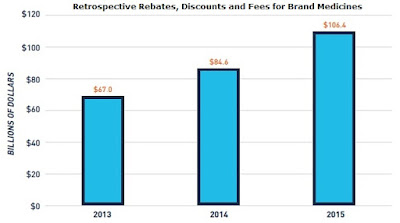 |
| Source: Berkeley Research Group |
Prescription drug benefit costs are steadily increasing for employers. Many mid-size to large employers work with pharmacy benefit managers (PBMs) to help them deliver generic and brand name prescription drugs to their employees in a cost-effective way. PBMs play an important role in providing access to high-quality medications to employees in today’s healthcare delivery model.
But what seems like a straightforward process of delivering generic and brand name drugs at agreed-upon prices can easily become murky. Sometimes, complicated contracts may define some generics as brand name drugs and exclude others from savings, costing employers tens of thousands, or even hundreds of thousands of dollars.
How brand and generic drugs are categorized
One benefit to working with a PBM is that they can save employers money through significant buying power. These savings are passed along to customers in the form of discounts that are often referred to as percent savings from the average wholesale price (AWP). PBMs typically offer a performance guarantee on factors like the brand-generic mix sometimes called generic fill rate (GFR) and percentage savings on brand name drugs, as well as a certain percentage of savings on generic drugs. If a PBM doesn’t achieve the agreed-upon performance guarantees —for example, 16% savings on brand name drugs and 60% savings on generic drugs and or 78% generic fill rate — the employer is reimbursed a specific amount.
This may seem like a simple agreement; however, PBMs can also dictate what they consider a brand name drug and a generic, and which drugs are excluded altogether from a performance guarantee. One of the largest PBMs in the country uses a term called the Brand Generic Algorithm, and the specific algorithm could differ from PBM to PBM.
For example, PBMs may exclude all single-source generic drugs from performance guarantees. Why? If a generic drug comes from a single source manufacturer, it could be considered a brand name drug, or excluded from the performance measurement altogether, even though it’s marketed to consumers as a generic.
One recent example is when the makers of the popular drug Crestor, which is used to treat high cholesterol, launched its generic version Rosuvastatin after the patent ran out on Crestor. Although a generic, Rosuvastatin was often considered a brand drug or excluded from the performance guarantee altogether of certain PBMs. Crestor and its generic Rosuvastatin are among the most prescribed drugs in an average workforce population. Therefore, you can see how one drug can skew performance guarantee results.
Excluded drugs can cost you
Manufacturer rebates for pharmaceutical drugs are another way PBMs can help employers save money. The first key to these cost savings is ensuring that the PBM is passing through 100% of rebates directly to the employer, rather than keeping all or a portion of rebates.
The second key to ensuring rebate cost savings is defining which drugs are actually eligible for rebates. For example, a close inspection of your PBM contract may include a 100% pass-through rate for rebates, meaning all manufacturer rebates are passed directly to you without the PBM retaining a percentage of the rebate. However, another part of your contract may state that specialty drugs are not eligible for rebates or that a certain percentage of the rebates on specialty are retained by the PBM. Specialty drugs tend to be more costly than typical brand name drugs; being ineligible for rebates might mean missing out on significant savings.
An example of the major impact that rebates can have on drug costs is the widely prescribed Hepatitis C drug Harvoni, which has a 90%-plus cure rate of the disease when taken properly. Under most prescription plans Harvoni would cost the plan sponsor around $100,000 for a standard course of treatment. What many employers don’t know is that the rebates from Gilead (the company that developed Harvoni) could be in excess of $35,000 per prescription. If your prescription drug contract excluded specialty rebates you could lose out on significant savings to the plan.
In both of these instances, the total costs and savings rates may look great when compiled in a spreadsheet beside other PBMs, but there are important details to consider that might change the actual savings. This doesn’t even take into consideration the impact of pricing inflation caps, utilization review and management, patient outreach, the most appropriate delivery channel, and other factors.
In today’s complicated healthcare environment, it’s almost a guarantee that employers will see increasing pharmacy costs even when the plan is negotiated and managed properly. That’s why it’s important to review PBM contracts carefully. An experienced, unbiased consultant can advocate for you with the PBM while ensuring you understand the nuances of the contract, you’re getting the right rebates, and that brand name vs. generic drugs are clearly understood and defined.
Continue Reading >>
